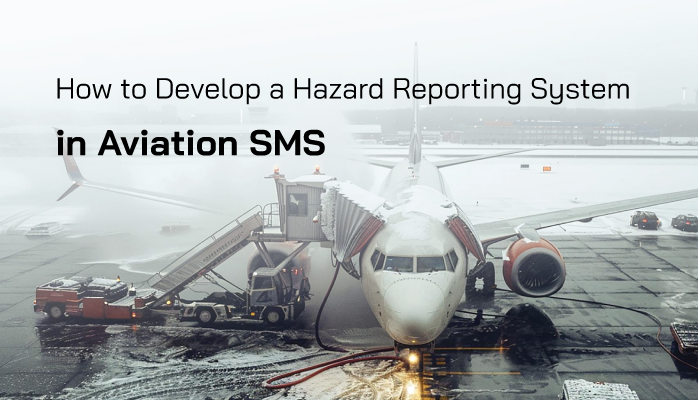What Is A Hazard Reporting System

A hazard reporting system encompasses the processes and resources your employees will use to report concerns.
The implication here is that your hazard reporting system is the primary means by which you will acquire feedback from operations (acquire data) and improve your SMS.
A hazard reporting system is a core part of driving your:
- Safety Risk Management process, by providing new data with which you will update your SMS design; and
- Safety Assurance Process, by monitoring safety performance and driving continuous improvement on an ongoing basis.
Your hazard reporting process is important because it is:
- First barrier hazard actualization;
- Primary way to identify hazard;
- Basis upon which most safety decisions are made; and
- Main catalyst for new risk controls and continuous improvement.
Here is how you develop a hazard reporting system.
Include Multiple Hazard Reporting Forms
The importance of high quality hazard reporting forms cannot be underestimated. Hazard reporting is the foundation of your SMS programs in terms of:
- Acquiring data;
- Managing issues;
- Continuous improvement; and
- Hazard identification.
Having relevant hazard reporting forms that are well-designed offers the following core benefits:
- Capture only data you need;
- No need to waste time following up with reporters to gather more information; and
- Incentive for employees to report issues.
When reporting forms are too long, too short, or contain irrelevant form fields, it will make employees not want to report and waste their time.
Provide at Least Three Ways to Report Issues
Having multiple ways to report issues is very important, such as via:
- Your standard reporting process;
- Email;
- Text message;
- Offline;
- From a mobile device; or
- From public links, such as on your website.
Proving many ways to report issues allows employees to report issues as they happen, especially when they might not otherwise report later on if it is not convenient.
Related Articles on Reporting Issues in Aviation SMS
- Should Reported Safety Issues Be Confidential in Aviation SMS
- 5 Best Ways to Make Reporting Safety Issues More Convenient in Aviation SMS
- What Issues Employees Should Be Reporting in Your SMS
Provide a Policy for Mandatory and Voluntary Issue Reporting

Mandatory and voluntary issue reporting policies are very helpful for employees. This policy can simply contain two lists:
- Issues that are mandatory to report, such as injuries, intoxication, etc.; and
- Issues that are voluntary to report, such as missed tool counts, procedure not followed, etc.
This policy gives employees guidance on:
- What kinds of issues management feels are most important;
- What kinds of issues they must report, else face consequences; and
- What kinds of issues management encourages reporting but are not essential?
This policy can easily be created and distributed to employees for training once per year.
Provide and Distribute Non-Punitive Reporting Policy
A non-punitive reporting policy is very important for cultivating a positive hazard reporting culture and, in turn, safety culture. This policy is basically your way of telling employees;
- They won’t get in trouble for self-reporting;
- They won’t be blamed for issues;
- How management holds reporting issues above employee mistakes; and
- Ground for when they would face consequences, such as by not reporting mandatory issues.
This policy should be distributed to all new employees, and existing employees at least once per year.
Create Process to Follow Up With Reporters
Following up with reporters on all issues is a best practice for creating a hazard reporting system. Follow-up includes:
- Thanking them for submitting an issue; and
- Informing them how their report was managed (when complete).
This communicates to employees that:
- You value their participation;
- They are involved in the SMS when they report; and
- Their reports are valuable for inciting safety changes.
Follow-up is a best practice that has many benefits for safety culture, and it encourages employees to continue reporting.
Provide Means of Confidential Reporting
Confidential reporting is a mandatory compliance requirement for hazard reporting systems. Basically, this simply entails that you develop some means that allow employees to submit confidential issues and ensure that their privacy will be protected.
Often, this is done via a hazard reporting system software with built-in confidential reporting, or by designating a specific member of your organization (such as an HR manager) as the person to whom employees will report confidential issues.
Provide Hazard Reporting Training to Employees
Of course, a hazard reporting system with employees who aren’t good at identifying hazards will not perform well. Extensive hazard reporting systems provide employees with the necessary awareness and tools to:
- Report problems before the hazard occurs;
- Identify hazardous sources;
- Behave very safety; and
- Mitigate situations in the event of a hazard occurrence.
Hazard identification training should be included as an initial and recurring SMS training requirement for all employees.
Train Employees on the Hazard Reporting Process and Resources
Finally, employees need to know how to use your hazard reporting system. If they are 100% comfortable using the system and reporting issues, they will report many more issues than if they were unfamiliar with the process.
The process should be as simple as possible, and part of training employees on how to use it is to also acquire feedback on if/how the process can be improved. Training employees on your hazard reporting system should be done during initial SMS training.
Last updated November 2025.





